The ASUS ROG Strix GL502VS Review: Mainstream GTX 1070 with G-SYNC
by Brett Howse on December 9, 2016 8:00 AM ESTGPU Performance
The big update with the GL502VS over the previous model is NVIDIA’s new Pascal based GTX 1070, replacing the outgoing GTX 980M on the GL502VY. We’ve gone over this before when the GTX 10-series launched for notebooks, but this is a significant departure from previous mobile GPUs from NVIDIA. We’ve seen this coming over the years, with mobile GPUs and desktop GPUs being based on the same architecture, and the performance delta between them shrinking every year, but with the release of the 10-series, NVIDIA has dropped the M branding for mobile.
This doesn’t mean it’s the same GPU in a notebook as a desktop, but in NVIDIA’s eyes, the performance of the desktop and notebook part are close enough that they feel they can brand them the same. It also makes it easier for the consumer, because a GTX 1070 is a GTX 1070, more or less, when discussing performance, where as the GTX 980M was a pretty big step down from the GTX 980 (which did eventually find its way into high end gaming notebooks near the end of its life). The notebook version of the GTX 1070 is one of the most interesting of the bunch, since it actually has more CUDA cores than the desktop part, at 2048 compared to 1920 on the desktop. The core and boost clock are a bit lower than the desktop part, which means NVIDIA went for a bit of a wide and slow approach to meet their TDP goals, although that is all relative, since it’s far from slow.
The ASUS GL502VS was put through the notebook workload for GPUs, with a couple of new games added as well. To compare it to any other notebook we’ve tested, please use our online bench. First up is some synthetic tests, followed by gaming results.
3DMark
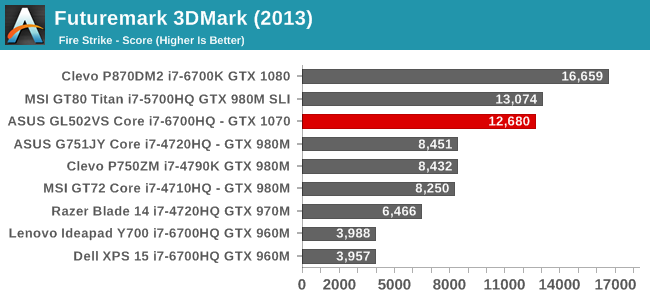
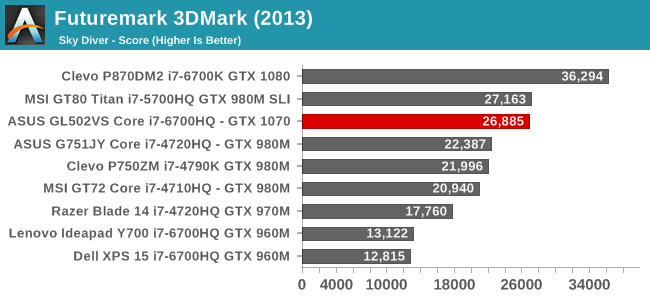
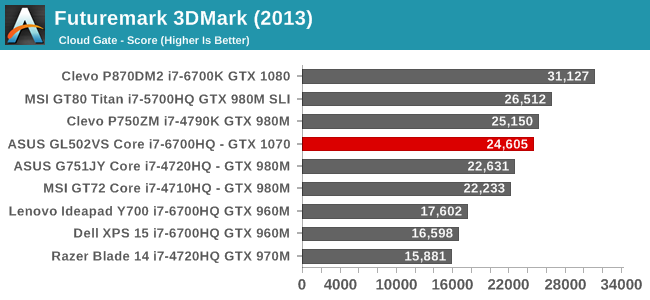
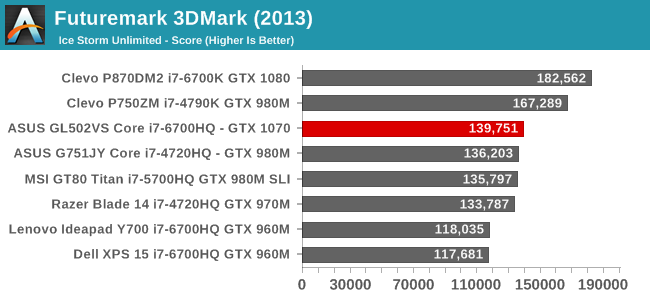
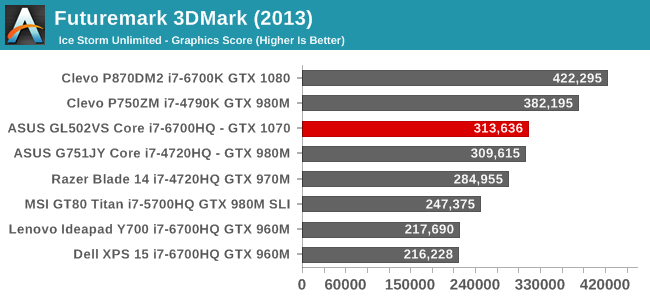
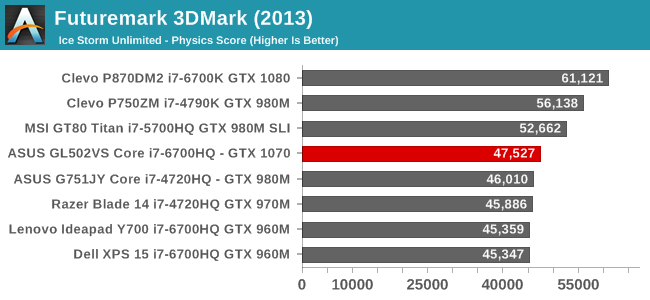
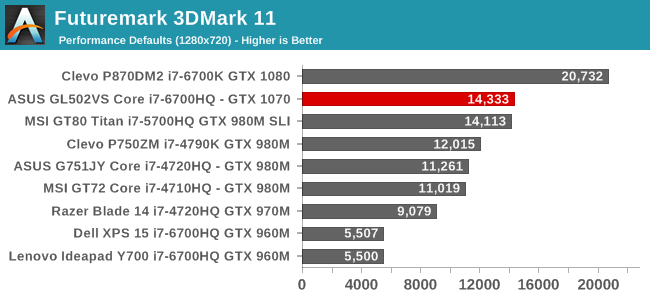
With the more difficult tests of Fire Strike and Sky Diver, the GTX 1070 is within spitting distance of the MSI GT80 Titan with SLI GTX 980M, showing just what a jump in performance the GTX 1070 is. One step under the GTX 1080, and there is still roughly the same performance as the best SLI laptop available with Maxwell. Not a bad start.
GFXBench
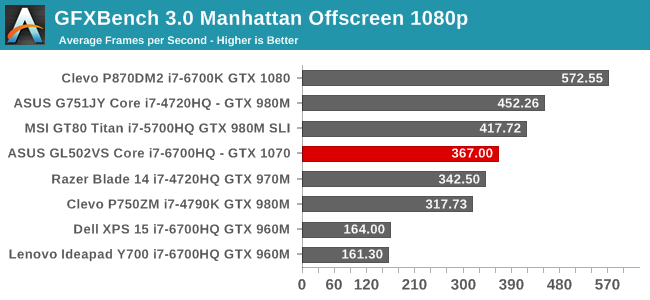
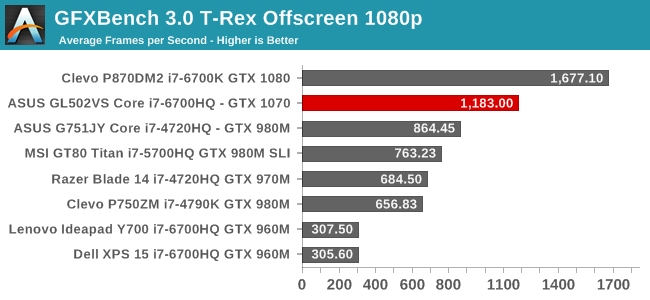
Both of the tests from the older version of GFXBench are really starting to show their age, with scores that are on the far side of ridiculous. The T-Rex scores are kind of insane for both of the Pascal laptops, with results well over 1000 frames per second. The latest version of the test includes some more difficult rendering, and this version will be the new default very soon.
Dota 2 Reborn
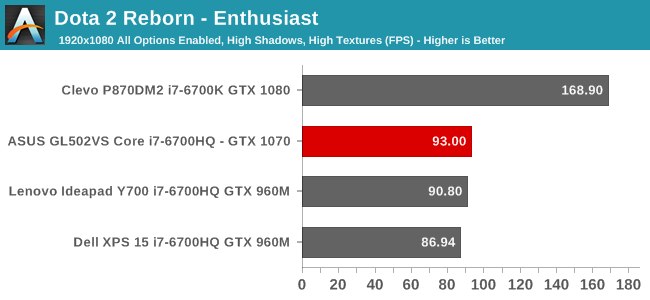
Valve updated the Dota 2 engine quite a while back now, and despite their best efforts, it is still largely a CPU bound test. The GTX 1070 would normally run laps around a GTX 960M, but they are within a couple frames per second of each other with the same CPU available, while the Clevo runs away with this test thanks to the inclusion of a desktop class 95-Watt processor.
Tomb Raider

Although several years old, with everything at maximum Tomb Raider can still be punishing to slower graphics processing units, but with the benefits of Pascal and a much more power efficient architecture, the ASUS GL502VS is once again right on the heels of the SLI GTX 980M found in the GT80 Titan. That seems to be a pretty consistent result, which is very impressive for a mid-range GPU.
Rise of the Tomb Raider

The latest version of Tomb Raider is a beautiful game to look at, especially with everything at maximum. The ASUS compares very well here, still averaging almost 100 frames per second. Be warned though, ASUS does offer a version of this laptop with a 4 GB GPU, and you need more than 4 GB of memory to run this game at its maximum settings, so be sure to future proof yourself with an 8 GB model.
Civilization VI



Although the game is new, the underlying engine is pretty much the same, and Civilization continues to be a mostly CPU bound game. Since the last review of the GTX 1080 Clevo, the benchmark has been updated and the scores from that system are no longer valid, so for the time being there is just a single result here, but as you can see there is very little difference between maximum settings and minimum, as far as frame rate. Interestingly they’ve also added a new test to determine the average amount of time between turns, and that should be useful for future reviews as a CPU test.
Bioshock Infinite
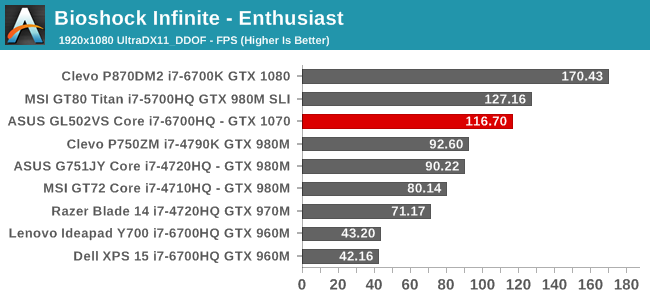
Once again this game is getting a bit old, but it’s still very fun, and can be quite demanding at maximum settings. Pascal is really taking this game for granted though, as even on the maximum settings the frame rate is still very high, and once again it is right behind SLI GTX 980M.
Dragon Age: Inquisition
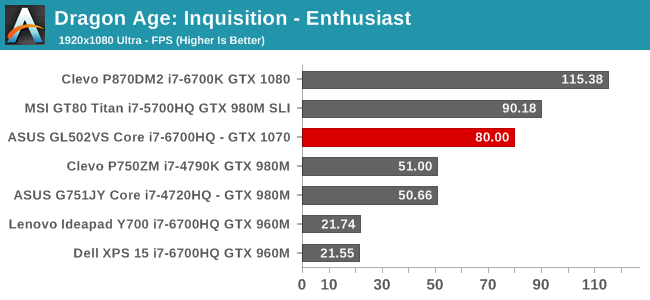
Although behind the GT80 Titan, the ASUS GL502VS is very much right up there when playing this amazing RPG from the end of 2014. There is a healthy step up from the GTX 980M, and the GTX 960M cards aren’t even playable at these settings.
Shadow of Mordor
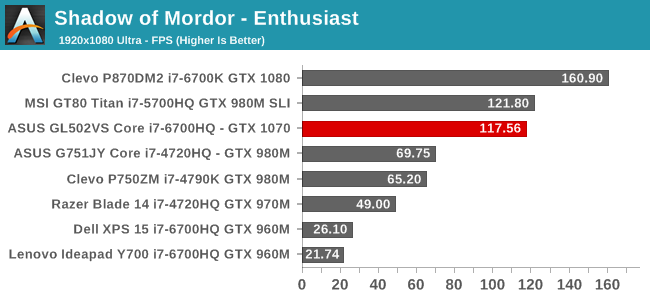
The theme continues, with the GTX 1070 only a hair behind the SLI gaming powerhouse from a year ago.
Grid Autosport
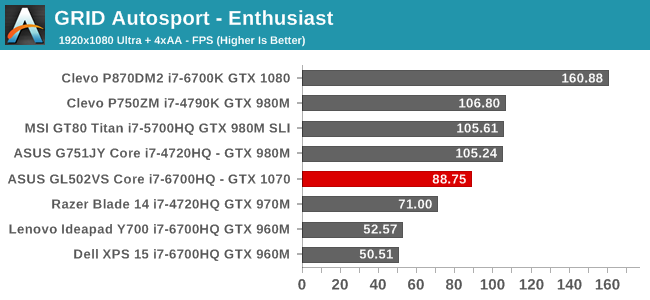
Here we see a bit of a role reversal, with the GTX 1070 falling slightly behind the GTX 980M. This game tends to be CPU bound though, and it’s likely a driver optimization issue here. Regardless, at almost 90 frames per second, it is still not a problem to play.
GPU Conclusion
Maxwell was a big launch for NVIDIA, and the GTX 980M continues to be a pretty powerful GPU, but with FinFET available, Pascal based cards are a huge jump in efficiency. It seems to be pretty consistent in the tests that the GTX 1070 was neck to neck with the SLI GTX 980M, while the GTX 1080 jumps clear of everything by a big margin. The step down to the GTX 1070 from the GTX 1080 is a decent sized step, but regardless the performance of the GTX 1070 is very impressive. Compared to a gaming laptop from a year ago, the ASUS GL502VS is basically on par with the fastest SLI laptops around which is quite an accomplishment.
Most of these games would be playable at UHD resolution (3840x2160) but some of the settings would have to be tweaked for better performance. There isn’t quite enough headroom like on the GTX 1080 to really go for UHD gaming. Just be sure to pick up the 8 GB graphics card to avoid issues in the future, since both a 4 GB and 8 GB model are available.










54 Comments
View All Comments
nathanddrews - Friday, December 9, 2016 - link
Is $1600 mainstream?Hopefully we see FreeSync (or G-Sync) laptops on the "low end" $800 laptops. Seems like a ripe market for Adaptive Sync technologies, given the lesser performance of GTX 960m and similar parts.
close - Friday, December 9, 2016 - link
Given the prices I saw recently on deeply flawed (unbalanced) gaming machines, ~$1600 for something that comes with more than decent CPU, GPU and SSD might as well be called mainstream. The rest is still compromised as opposed to a proper gaming machine (small screen, integrated keyboard and touchpad) but at least you get a reasonable package for a relatively reasonable price.Do not compare it to a desktop. The desktop will still be twice as cheap and a lot more powerful for a long time.
xenol - Friday, December 9, 2016 - link
Find me a complete desktop system (that includes all of I/O) that performs about the same for half the cost.sorten - Friday, December 9, 2016 - link
It would be difficult to find a comparable desktop for the comparison. You could probably go with an i5 65W CPU and it would significantly outperform the laptop's 45W i7. The 1070 is the same for desktop and mobile, but much more thermal headroom on the desktop. Memory and SSDs are cheap. I also wouldn't count the cost of the monitor in the comparison, because the only time I wouldn't dock the laptop so I could use my 27" monitor would be in the rare trip to a hotel or similar place.The other thing is that anyone who is building a desktop for gaming is only replacing one or two components. For example, I could build a faster desktop gaming system than this laptop by just spending the $400 on the GPU. I've had the same case, PSU, optical drive, etc. for probably 7 or 8 years.
Samus - Sunday, December 11, 2016 - link
The other thing to keep in mind is you can build a mini ITX system with an i7 and GTX1070 while still being incredibly tiny, less expensive and more capable (aside from being slightly more bulky and lacking battery power.)But that's the real killer with gaming laptops. Unless they are DTR's, they are too weak in graphics performance, and when they are DTR's, battery life is a joke anyway.
close - Tuesday, December 13, 2016 - link
@xenol, if it's any easier for you to understand read it as "performance/$". Or do you specifically want me to lookup some desktop CPUs/GPUs that are gimped by thermal headroom to match the equivalent laptop ones, a case that allows for close to 0 upgradeability, a 15" mediocre screen, crappy keyboard, integrated buzzers... erm, speakers, and a touchpad instead of a mouse?I was talking more of a hypothetical equivalent since it's hard to build a desktop that matches *any* gaming laptop in compromises. Yeah, I get that if you want portability a laptop is the way to go. It's still a severely compromised machine, it's still extremely expensive for the hardware but maybe the difference is how much "portability" costs.
Donny2005UK - Wednesday, January 11, 2017 - link
https://www.amazon.com/Lenovo-Ideacentre-Y700-Desk... Sorry cheapest I could find with a decent cpumrmcmurren - Wednesday, February 1, 2017 - link
hey if you are intested i am selling my desktop with better specs for a great price 1200email me at mrmcmurren@gmail.com
specs as follows
BLUETOOTH: None
CASUPGRADE: None
CD: 24X Double Layer Dual Format DVD+-R/+-RW + CD-R/RW Drive (BLACK COLOR)
CD2: None
COOLANT: Standard Coolant
CPU: Intel(R) Core� i7-3820 Quad-Core 3.60 GHz 10MB Intel Smart Cache LGA2011 (All Venom OC Certified)
CS_FAN: Maximum 120MM Color Case Cooling Fans for your selected case
FA_HDD: None
FAN: Asetek 510LC Liquid Cooling System 120MM Radiator & Fan (Enhanced Cooling Performance + Extreme Silent at 20dBA) (Single Standard 120MM Fan)
FLASHMEDIA: None
GLASSES: None
HDD: 2TB (2TBx1) SATA-III 6.0Gb/s 64MB Cache 7200RPM HDD (Single Drive)
HDD2: None
IEEE_CARD: None
MEMORY: 16GB (4GBx4) DDR3/1866MHz Quad Channel Memory (Corsair Vengeance [Free upgrade from 1600MHz Major Brand])
MONITOR: None
MONITOR2: None
MONITOR3: None
MOTHERBOARD: (3-Way SLI/CrossFireX Support) ASUS P9X79 LE Intel X79 Chipset Quad Channel DDR3 ATX w/ Remote GO!, 7.1 HD Audio, GbLAN, 3 Gen3 PCIe X16, 2 PCIe X1 & 1 PCI
NETWORK: Onboard Gigabit LAN Network
OS: Microsoft(R) Windows 8 Pro (64-bit Edition)
OVERCLOCK: No Overclocking
POWERSUPPLY: 800 Watts - Standard Power Supply - SLI/CrossFireX Ready
SOUND: HIGH DEFINITION ON-BOARD 7.1 AUDIO
SPEAKERS: None
TEMP: None
TUNING: None
TVRC: None
USB: None
USBFLASH: None
USBHD: None
USBX: None
VIDEO: GTX 1070 AMP Mini
JoeyJoJo123 - Friday, December 9, 2016 - link
Desktop PCs are cheaper, and are more serviceable, and you avoid the pitfalls of going with a prebuilt system loaded with adware, or in the worst case with Lenovo's Superfish, blatant malware. However, I think you're overestimating the cost of PC ownership, and assume that a complete PC system with peripherals is _half_ the cost of a gaming laptop.GTX 1070 laptop video cards are very roughly comparable to desktop GTX 1070 performance, and Nvidia's gone a long way to help bridge the gap between mobile and desktop class performance. A balanced GTX 1070 PC build will cost ~$1000, with no peripherals or OS. Add in a basic 1080p monitor, mouse, keyboard, etc. and you're at $1250 or so. So the $1600 laptop isn't a farcry from what PC build enthusiasts would claim.
You pay about a 25% premium, I'd think for the compactness and convenience of a fully ready platform. But given that time is a resource, it's not an unjust cost for people who just want a system to be ready without the hassle of the PC building research, parts acquisition, and assembly.
These days prebuilt systems are cheaper than ever, so the argument that building your own PC saves a lot of money is losing its argument. I still do it as it's a fun hobby for me, but I know it's not for everyone.
xenol - Friday, December 9, 2016 - link
I'm poking fun of the desktop fanboy that every time they say "I can make a desktop build for cheaper!" they seem to fail to remember a laptop is a complete system. I'm all for price comparing, but please, make it as apples to apples as possible.It's like every time someone goes "I can make a $400 PC that can best a PS4" fails to account for the fact a PS4 also comes with a $60 controller and a BD drive. I mean, as a pure gaming machine, maybe. But at the same time, if I wanted something that could replace the PS4 as much as possible, I need that BD drive.
I mean, I didn't buy a PlayStation just to play games. I bought it because it's also a media player.